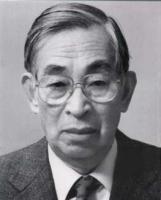Itô Kiyoshi
(07.09.1915 - 10.11.2008)
Kiyosi Ito studied mathematics in the Faculty of Science of the Imperial University of Tokyo. It was during his student years that he became attracted to probability theory.
In 1938 Ito graduated from the University of Tokyo and in the following year he was appointed to the Cabinet Statistics Bureau. He worked there until 1943 and it was during this period that he made his most outstanding contributions.
In 1940 he published On the probability distribution on a compact group on which he collaborated with Yukiyosi Kawada. The background to Ito's famous 1942 paper On stochastic processes (Infinitely divisible laws of probability) which he published in the Japanese Journal of Mathematics is given in [2]:-
Brown, a botanist, discovered the motion of pollen particles in water. At the beginning of the twentieth century, Brownian motion was studied by Einstein, Perrin and other physicists. In 1923, against this scientific background, Wiener defined probability measures in path spaces, and used the concept of Lebesgue integrals to lay the mathematical foundations of stochastic analysis. In 1942, Dr. Ito began to reconstruct from scratch the concept of stochastic integrals, and its associated theory of analysis. He created the theory of stochastic differential equations, which describe motion due to random events.
Although today we see this paper as a fundamental one, it was not seen as such by mathematicians at the time it was published. Ito, who still did not have a doctorate at this time, would have to wait several years before the importance of his ideas would be fully appreciated and mathematicians would begin to contribute to developing the theory. In 1943 Ito was appointed as Assistant Professor in the Faculty of Science of Nagoya Imperial University. This was a period of high activity for Ito, and when one considers that this occurred during the years of extreme difficulty in Japan caused by World War II, one has to find this all the more remarkable. Volume 20 of the Proceedings of the Imperial Academy of Tokyo contains six papers by Ito: (1) On the ergodicity of a certain stationary process; (2) A kinematic theory of turbulence; (3) On the normal stationary process with no hysteresis; (4) A screw line in Hilbert space and its application to the probability theory; (5) Stochastic integral; and (6) On Student's test.
In 1945 Ito was awarded his doctorate. He continued to develop his ideas on stochastic analysis with many important papers on the topic. Among them were On a stochastic integral equation (1946), On the stochastic integral (1948), Stochastic differential equations in a differentiable manifold (1950), Brownian motions in a Lie group (1950), and On stochastic differential equations (1951).
In 1952 Ito was appointed to a Professorship at Kyoto University. In the following year he published his famous text Probability theory. In this book, Ito develops the theory on a probability space using terms and tools from measure theory. The years 1954-56 Ito spent at the Institute for Advanced Study at Princeton University. An important publication by Ito in 1957 was Stochastic processes. This book contained five chapters, the first providing an introduction, then the remaining ones studying processes with independent increments, stationary processes, Markov processes, and the theory of diffusion processes. In 1960 Ito visited the Tata Institute in Bombay, India, where he gave a series of lectures surveying his own work and that of other on Markov processes, Levy processes, Brownian motion and linear diffusion.
Although Ito remained as a professor at Kyoto University until he retired in 1979, he also held positions as professor at Aarhus University from 1966 to 1969 and professor at Cornell University from 1969 to 1975. During his last three years at Kyoto before he retired, Ito was Director of the Research Institute for Mathematical Sciences there. After retiring from Kyoto University in 1979 he did not retire from mathematics but continued to write research papers. He was also appointed at Professor at Gakushuin University.
Ito received many honours for his outstanding mathematical contributions. He was awarded the Asahi Prize in 1978, and in the same year he received the Imperial Prize and also the Japan Academy Prize. In 1985 he received the Fujiwara Prize and in 1998 the Kyoto Prize in Basic Sciences from the Inamori Foundation. These prizes were all from Japan, and a further Japanese honour was his election to the Japan Academy. However, he also received many honours from other countries. He was elected to the National Academy of Science of the United States and to the Académie des Sciences of France. He received the Wolf Prize from Israel and honorary doctorates from the universities of Warwick, England and ETH, Zurich, Switzerland.
Nowadays, Dr. Ito's theory is used in various fields, in addition to mathematics, for analysing phenomena due to random events. Calculation using the "Ito calculus" is common not only to scientists in physics, population genetics, stochastic control theory, and other natural sciences, but also to mathematical finance in economics. In fact, experts in financial affairs refer to Ito calculus as "Ito's formula." Dr. Ito is the father of the modern stochastic analysis that has been systematically developing during the twentieth century. This ceaseless development has been led by many, including Dr. Ito, whose work in this regard is remarkable for its mathematical depth and strong interaction with a wide range of areas. His work deserves special mention as involving one of the basic theories prominent in mathematical sciences during this century.
from Article by: J J O'Connor and E F Robertson
http://www-history.mcs.st-and.ac.uk/Biographies/Ito.html
Впервые присуждалась премия Гаусса на Международном матеиатическом конгрессе в Мадриде в 2006 году. Ее первым лауреатом стал Киёси Ито.


